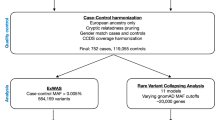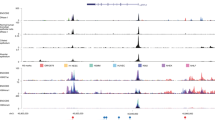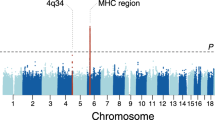Abstract
We performed a genome-wide association study of non-Hispanic, white individuals with fibrotic idiopathic interstitial pneumonias (IIPs; n = 1,616) and controls (n = 4,683), with follow-up replication analyses in 876 cases and 1,890 controls. We confirmed association with TERT at 5p15, MUC5B at 11p15 and the 3q26 region near TERC, and we identified seven newly associated loci (Pmeta = 2.4 × 10−8 to 1.1 × 10−19), including FAM13A (4q22), DSP (6p24), OBFC1 (10q24), ATP11A (13q34), DPP9 (19p13) and chromosomal regions 7q22 and 15q14-15. Our results suggest that genes involved in host defense, cell-cell adhesion and DNA repair contribute to risk of fibrotic IIPs.
This is a preview of subscription content, access via your institution
Access options
Subscribe to this journal
Receive 12 print issues and online access
$209.00 per year
only $17.42 per issue
Buy this article
- Purchase on Springer Link
- Instant access to full article PDF
Prices may be subject to local taxes which are calculated during checkout




Similar content being viewed by others
Change history
01 October 2013
In the version of this article initially published, the minor alleles for two SNPs (rs2076295 and rs7934606) were listed incorrectly in Table 1. The correct minor allele for rs2076295 is G, and the correct minor allele for rs7934606 is T. As a result, there were two incorrect statements in the text regarding the relationship between the disease risk allele of rs2076295 and DSP expression. The text should have stated that the allele of rs2076295 associated with increased risk of pulmonary fibrosis is associated with decreased DSP expression rather than increased DSP expression. These errors have been corrected in the HTML and PDF versions of the article.
References
American Thoracic Society & European Respiratory Society. American Thoracic Society/European Respiratory Society International Multidisciplinary Consensus Classification of the Idiopathic Interstitial Pneumonias. Am. J. Respir. Crit. Care Med. 165, 277–304 (2002).
Hubbard, R. et al. Exposure to commonly prescribed drugs and the etiology of cryptogenic fibrosing alveolitis: a case-control study. Am. J. Respir. Crit. Care Med. 157, 743–747 (1998).
Raghu, G. Idiopathic pulmonary fibrosis: new evidence and an improved standard of care in 2012. Lancet 380, 699–701 (2012).
Armanios, M.Y. et al. Telomerase mutations in families with idiopathic pulmonary fibrosis. N. Engl. J. Med. 356, 1317–1326 (2007).
Tsakiri, K.D. et al. Adult-onset pulmonary fibrosis caused by mutations in telomerase. Proc. Natl. Acad. Sci. USA 104, 7552–7557 (2007).
Thomas, A.Q. et al. Heterozygosity for a surfactant protein C gene mutation associated with usual interstitial pneumonitis and cellular nonspecific interstitial pneumonitis in one kindred. Am. J. Respir. Crit. Care Med. 165, 1322–1328 (2002).
Lawson, W.E. et al. Genetic mutations in surfactant protein C are a rare cause of sporadic cases of IPF. Thorax 59, 977–980 (2004).
Wang, Y. et al. Genetic defects in surfactant protein A2 are associated with pulmonary fibrosis and lung cancer. Am. J. Hum. Genet. 84, 52–59 (2009).
van Moorsel, C.H. et al. Surfactant protein C mutations are the basis of a significant portion of adult familial pulmonary fibrosis in a Dutch cohort. Am. J. Respir. Crit. Care Med. 182, 1419–1425 (2010).
Mushiroda, T. et al. A genome-wide association study identifies an association of a common variant in TERT with susceptibility to idiopathic pulmonary fibrosis. J. Med. Genet. 45, 654–656 (2008).
Seibold, M.A. et al. A common MUC5B promoter polymorphism and pulmonary fibrosis. N. Engl. J. Med. 364, 1503–1512 (2011).
Boucher, R.C. Idiopathic pulmonary fibrosis—a sticky business. N. Engl. J. Med. 364, 1560–1561 (2011).
Steele, M.P. et al. Clinical and pathologic features of familial interstitial pneumonia. Am. J. Respir. Crit. Care Med. 172, 1146–1152 (2005).
Zhang, Y., Noth, I., Garcia, J.G. & Kaminski, N. A variant in the promoter of MUC5B and idiopathic pulmonary fibrosis. N. Engl. J. Med. 364, 1576–1577 (2011).
Stock, C.J. et al. Mucin 5B promoter polymorphism is associated with idiopathic pulmonary fibrosis but not with development of lung fibrosis in systemic sclerosis or sarcoidosis. Thorax published online; 10.1136/thoraxjnl-2012-201786 (15 January 2013).
Boettger, L.M., Handsaker, R.E., Zody, M.C. & McCarroll, S.A. Structural haplotypes and recent evolution of the human 17q21.31 region. Nat. Genet. 44, 881–885 (2012).
Steinberg, K.M. et al. Structural diversity and African origin of the 17q21.31 inversion polymorphism. Nat. Genet. 44, 872–880 (2012).
Marchini, J., Howie, B., Myers, S., McVean, G. & Donnelly, P. A new multipoint method for genome-wide association studies by imputation of genotypes. Nat. Genet. 39, 906–913 (2007).
Guillouf, C., Gallais, I. & Moreau-Gachelin, F. Spi-1/PU.1 oncoprotein affects splicing decisions in a promoter binding–dependent manner. J. Biol. Chem. 281, 19145–19155 (2006).
Yang, J., Lee, S.H., Goddard, M.E. & Visscher, P.M. GCTA: a tool for genome-wide complex trait analysis. Am. J. Hum. Genet. 88, 76–82 (2011).
Rose, M.C. & Voynow, J.A. Respiratory tract mucin genes and mucin glycoproteins in health and disease. Physiol. Rev. 86, 245–278 (2006).
Crouch, E. Pathobiology of pulmonary fibrosis. Am. J. Physiol. (Lung Cell. Mol. Physiol. 4) 259, L159–L184 (1990).
Kuhn, C. et al. An immunohistochemical study of architectural remodeling and connective tissue synthesis in pulmonary fibrosis. Am. Rev. Respir. Dis. 140, 1693–1703 (1989).
Korfei, M. et al. Epithelial endoplasmic reticulum stress and apoptosis in sporadic idiopathic pulmonary fibrosis. Am. J. Respir. Crit. Care Med. 178, 838–846 (2008).
Alder, J.K. et al. Short telomeres are a risk factor for idiopathic pulmonary fibrosis. Proc. Natl. Acad. Sci. USA 105, 13051–13056 (2008).
Levy, D. et al. Genome-wide association identifies OBFC1 as a locus involved in human leukocyte telomere biology. Proc. Natl. Acad. Sci. USA 107, 9293–9298 (2010).
Mangino, M. et al. Genome-wide meta-analysis points to CTC1 and ZNF676 as genes regulating telomere homeostasis in humans. Hum. Mol. Genet. 21, 5385–5394 (2012).
Dickson, S.P., Wang, K., Krantz, I., Hakonarson, H. & Goldstein, D.B. Rare variants create synthetic genome-wide associations. PLoS Biol. 8, e1000294 (2010).
Orozco, G., Barrett, J.C. & Zeggini, E. Synthetic associations in the context of genome-wide association scan signals. Hum. Mol. Genet. 19, R137–R144 (2010).
Delva, E., Tucker, D.K. & Kowalczyk, A.P. The desmosome. Cold Spring Harb. Perspect. Biol. 1, a002543 (2009).
Awad, M.M., Calkins, H. & Judge, D.P. Mechanisms of disease: molecular genetics of arrhythmogenic right ventricular dysplasia/cardiomyopathy. Nat. Clin. Pract. Cardiovasc. Med. 5, 258–267 (2008).
Armstrong, D.K. et al. Haploinsufficiency of desmoplakin causes a striate subtype of palmoplantar keratoderma. Hum. Mol. Genet. 8, 143–148 (1999).
Whittock, N.V. et al. Striate palmoplantar keratoderma resulting from desmoplakin haploinsufficiency. J. Invest. Dermatol. 113, 940–946 (1999).
Whittock, N.V. et al. Compound heterozygosity for non-sense and mis-sense mutations in desmoplakin underlies skin fragility/woolly hair syndrome. J. Invest. Dermatol. 118, 232–238 (2002).
Al-Owain, M. et al. Novel homozygous mutation in DSP causing skin fragility–woolly hair syndrome: report of a large family and review of the desmoplakin-related phenotypes. Clin. Genet. 80, 50–58 (2011).
Yang, Z. et al. Desmosomal dysfunction due to mutations in desmoplakin causes arrhythmogenic right ventricular dysplasia/cardiomyopathy. Circ. Res. 99, 646–655 (2006).
Chilosi, M. et al. Aberrant Wnt/β-catenin pathway activation in idiopathic pulmonary fibrosis. Am. J. Pathol. 162, 1495–1502 (2003).
Henderson, W.R. Jr. et al. Inhibition of Wnt/β-catenin/CREB binding protein (CBP) signaling reverses pulmonary fibrosis. Proc. Natl. Acad. Sci. USA 107, 14309–14314 (2010).
Yang, L. et al. Desmoplakin acts as a tumor suppressor by inhibition of the Wnt/β-catenin signaling pathway in human lung cancer. Carcinogenesis 33, 1863–1870 (2012).
Acharya, P.S., Zukas, A., Chandan, V., Katzenstein, A.L. & Pure, E. Fibroblast activation protein: a serine protease expressed at the remodeling interface in idiopathic pulmonary fibrosis. Hum. Pathol. 37, 352–360 (2006).
Yu, D.M., Wang, X.M., Ajami, K., McCaughan, G.W. & Gorrell, M.D. DP8 and DP9 have extra-enzymatic roles in cell adhesion, migration and apoptosis. Adv. Exp. Med. Biol. 575, 63–72 (2006).
Janssens, B. et al. αT-catenin: a novel tissue-specific β-catenin–binding protein mediating strong cell-cell adhesion. J. Cell Sci. 114, 3177–3188 (2001).
Laurén, J., Airaksinen, M.S., Saarma, M. & Timmusk, T. A novel gene family encoding leucine-rich repeat transmembrane proteins differentially expressed in the nervous system. Genomics 81, 411–421 (2003).
Cho, M.H. et al. Variants in FAM13A are associated with chronic obstructive pulmonary disease. Nat. Genet. 42, 200–202 (2010).
Zhang, B., Groffen, J. & Heisterkamp, N. Resistance to farnesyltransferase inhibitors in Bcr/Abl-positive lymphoblastic leukemia by increased expression of a novel ABC transporter homolog ATP11a. Blood 106, 1355–1361 (2005).
Shulenin, S. et al. ABCA3 gene mutations in newborns with fatal surfactant deficiency. N. Engl. J. Med. 350, 1296–1303 (2004).
Bullard, J.E., Wert, S.E., Whitsett, J.A., Dean, M. & Nogee, L.M. ABCA3 mutations associated with pediatric interstitial lung disease. Am. J. Respir. Crit. Care Med. 172, 1026–1031 (2005).
Young, L.R. et al. Usual interstitial pneumonia in an adolescent with ABCA3 mutations. Chest 134, 192–195 (2008).
Soler Artigas, M. et al. Genome-wide association and large-scale follow up identifies 16 new loci influencing lung function. Nat. Genet. 43, 1082–1090 (2011).
Katoh, Y. & Katoh, M. Hedgehog signaling pathway and gastric cancer. Cancer Biol. Ther. 4, 1050–1054 (2005).
Selman, M., Pardo, A. & Kaminski, N. Idiopathic pulmonary fibrosis: aberrant recapitulation of developmental programs? PLoS Med. 5, e62 (2008).
Gross, T.J. & Hunninghake, G.W. Idiopathic pulmonary fibrosis. N. Engl. J. Med. 345, 517–525 (2001).
King, T.E. Jr. et al. Effect of interferon γ-1b on survival in patients with idiopathic pulmonary fibrosis (INSPIRE): a multicentre, randomised, placebo-controlled trial. Lancet 374, 222–228 (2009).
Regan, E.A. et al. Genetic epidemiology of COPD (COPDGene) study design. COPD 7, 32–43 (2010).
Patterson, N., Price, A.L. & Reich, D. Population structure and eigenanalysis. PLoS Genet. 2, e190 (2006).
Heath, S.C. et al. Investigation of the fine structure of European populations with applications to disease association studies. Eur. J. Hum. Genet. 16, 1413–1429 (2008).
Cortes, C. & Vapnik, V. Support-vector networks. Mach. Learn. 20, 273–297 (1995).
Hansen, B.B. & Klopfer, S.O. Optimal full matching and related designs via network flows. J. Comput. Graph. Statist. 15, 1–19 (2006).
Harley, J.B. et al. Genome-wide association scan in women with systemic lupus erythematosus identifies susceptibility variants in ITGAM, PXK, KIAA1542 and other loci. Nat. Genet. 40, 204–210 (2008).
Zhou, X. & Stephens, M. Genome-wide efficient mixed-model analysis for association studies. Nat. Genet. 44, 821–824 (2012).
Willer, C.J., Li, Y. & Abecasis, G.R. METAL: fast and efficient meta-analysis of genomewide association scans. Bioinformatics 26, 2190–2191 (2010).
Pruim, R.J. et al. LocusZoom: regional visualization of genome-wide association scan results. Bioinformatics 26, 2336–2337 (2010).
Delaneau, O., Zagury, J.F. & Marchini, J. Improved whole-chromosome phasing for disease and population genetic studies. Nat. Methods 10, 5–6 (2013).
Delaneau, O., Marchini, J. & Zagury, J.F. A linear complexity phasing method for thousands of genomes. Nat. Methods 9, 179–181 (2012).
Howie, B.N., Donnelly, P. & Marchini, J. A flexible and accurate genotype imputation method for the next generation of genome-wide association studies. PLoS Genet. 5, e1000529 (2009).
Howie, B., Marchini, J. & Stephens, M. Genotype imputation with thousands of genomes. G3 (Bethesda) 1, 457–470 (2011).
Marchini, J. & Howie, B. Genotype imputation for genome-wide association studies. Nat. Rev. Genet. 11, 499–511 (2010).
Acknowledgements
We gratefully acknowledge the individuals who participated in the studies that contributed to this work. This research was supported by the National Heart, Lung, and Blood Institute (R01-HL095393, R01-HL097163, P01-HL092870, RC2-HL101715, U01-HL089897, U01-HL089856, U01-HL108642 and P50-HL0894932), the Veterans Administration (1I01BX001534), the Dorothy P. and Richard P. Simmons Center and InterMune.
Author information
Authors and Affiliations
Contributions
T.E.F. and D.A.S. designed the study. K.K.B., M.P.S., J.E.L., G.P.C., D.L., S.G., H.R.C., P.J.W., R.M.d.B., C.K.G., M.S.D., G.G., H.J.I., N.K., Y.Z., K.F.G., L.H.L., W.R.M., T.M.M., P.L.M., A.U.W., J.D. Crapo, B.J.M., E.A.R. and M.I.S. performed clinical, radiological and pathological phenotyping of study subjects. W.Z.B., K.K. and S.D.S. provided data and samples from the InterMune subjects. J.T., R.N.K. and C.R.M. coordinated the clinical evaluations. E.M. supervised and coordinated the laboratory work. E.M., J.D. Cogan, D.S.W., J.J.D., D.Z. and K.S. performed the laboratory work. D.M. organized the database. K.B.B. supervised the replication genotyping. M.L. supervised the genome-wide genotyping. M.F.M., M.S., A.P., D.S.K. and M.I.S. provided advice on design and relevance to pulmonary fibrosis. T.E.F., W.Z., A.L.P., B.S.P. and Y.K. analyzed the data. T.E.F., M.L. and D.A.S. developed the conceptual approaches to data analysis. T.E.F. and D.A.S. wrote the manuscript.
Corresponding authors
Ethics declarations
Competing interests
The authors have filed applications with the US Patent Office entitled 'Methods and Compositions for Risk Prediction, Diagnosis, Prognosis, and Treatment of Pulmonary Disorders' (application serial number 61/298473; D.A.S. and T.E.F.) and 'Use of MUC5B Gene Expression in Therapeutics' (application serial number 61/693861; D.A.S.).
Supplementary information
Supplementary Text and Figures
Supplementary Tables 1–11 and Supplementary Figures 1–4 (PDF 1443 kb)
Rights and permissions
About this article
Cite this article
Fingerlin, T., Murphy, E., Zhang, W. et al. Genome-wide association study identifies multiple susceptibility loci for pulmonary fibrosis. Nat Genet 45, 613–620 (2013). https://doi.org/10.1038/ng.2609
Received:
Accepted:
Published:
Issue Date:
DOI: https://doi.org/10.1038/ng.2609
This article is cited by
-
Cell-type-specific and disease-associated expression quantitative trait loci in the human lung
Nature Genetics (2024)
-
Epithelial senescence in idiopathic pulmonary fibrosis is propagated by small extracellular vesicles
Respiratory Research (2023)
-
KIF15 missense variant is associated with the early onset of idiopathic pulmonary fibrosis
Respiratory Research (2023)
-
Walking the path of treatable traits in interstitial lung diseases
Respiratory Research (2023)
-
Morphologically intact airways in lung fibrosis have an abnormal proteome
Respiratory Research (2023)



